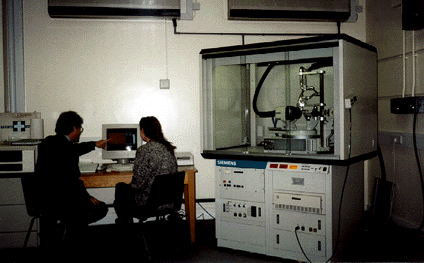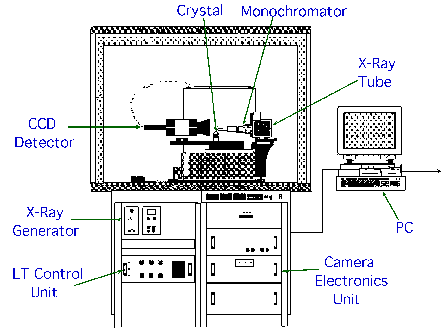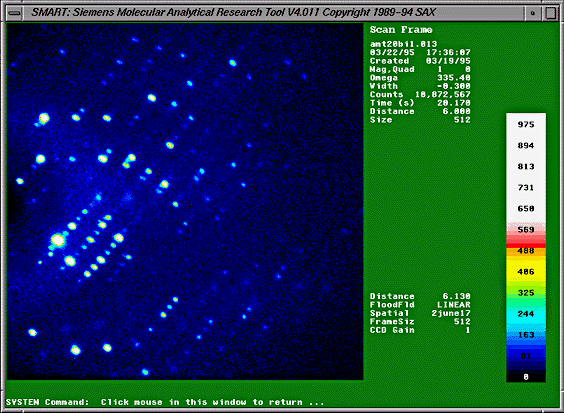
In 1995 the School of Chemistry purchased a SMART diffractometer from Siemens (the X-ray analytical division of Siemens has recently been sold to Bruker and is now known as Bruker AXS). The diffractometer has an area detector and can collect a complete dataset for a crystal in less than six hours. Whereas traditional diffractometers use point detectors, which measure the intensity of each diffracted beam individually in sequence, an area detector records the diffraction pattern over a large area of reciprocal space simultaneously. The image is then stored digitally as a 'frame' of diffracted intensity information. Many frames are collected in turn, as the crystal is rotated in a series of small steps. The frames are then analysed, and the intensity of each individual 'reflection' can be determined.

The X-ray generator uses a standard water-cooled W-filament source, which produces Mo K-alpha radiation and is typically used at 50 kV and 40 mA (2 kW power). The CCD (charge-coupled device) area detector has a 2-dimensional array of photodiodes (1024 x 1024 elements) coupled by fibre-optics to a light-sensitive phosphor screen - when X-rays strike the screen, light is produced, the intensity of which is measured by the photodiodes. The detector operates at -55 °C for optimum signal to noise ratio. The analogue signal from the detector is digitised by the camera electronics unit, which allows for adjustment of detector gain, exposure times etc., under control of the attached Pentium PC. The data are transferred to a local network of Silicon Graphics computers, which are used for data storage and analysis, and structure refinement.

The SMART (Siemens Molecular Analytical Research Tool) software controls the operation of the diffractometer, including equipment calibration, orientation matrix calculation and the recording of frames of diffracted intensity data. Frames are typically measured in 3 or 4 batches; for omega scan data, within each batch the chi and phi angles are fixed and the crystal is rotated around omega, normally in steps of 0.3°. Different batches are collected with different starting values for phi. This results in a measurement of series of closely-spaced cross-sections of reciprocal space, hence 3-dimensional diffraction information is obtained. In total, up to 1200 frames are normally acquired, which corresponds to a 2theta coverage of 0 to 55°, but these limits may be changed if necessary (e.g. if more data are required).
A typical programme frame for a strongly-diffracting crystal is shown below. The vertical colour bar is used to adjust the contrast to optimise the observed diffraction pattern.

A movie showing the diffraction pattern as the crystal is rotated in a sequence of 44 frames is available as an MPEG file (403 Kb) or in macintosh quicktime format (735 Kb).
The SAINT (Siemens Area detector INTegration) program is used to integrate the raw frame data from the area detector and produce a scaled and merged set of reflection intensities. Corrections for absorption effects and crystal decay are possible, as well as merging of data from different collection batches and/or different crystals. Integration can be performed concurrently as the frames are being collected, so that a reflection data file is available for structure solution immediately after the frame data collection has finished.
|
|
|
|
|
| Maintained by webmaster@xray.chm.bris.ac.uk | This research group is part of the School of Chemistry , |
| at the University of Bristol. |